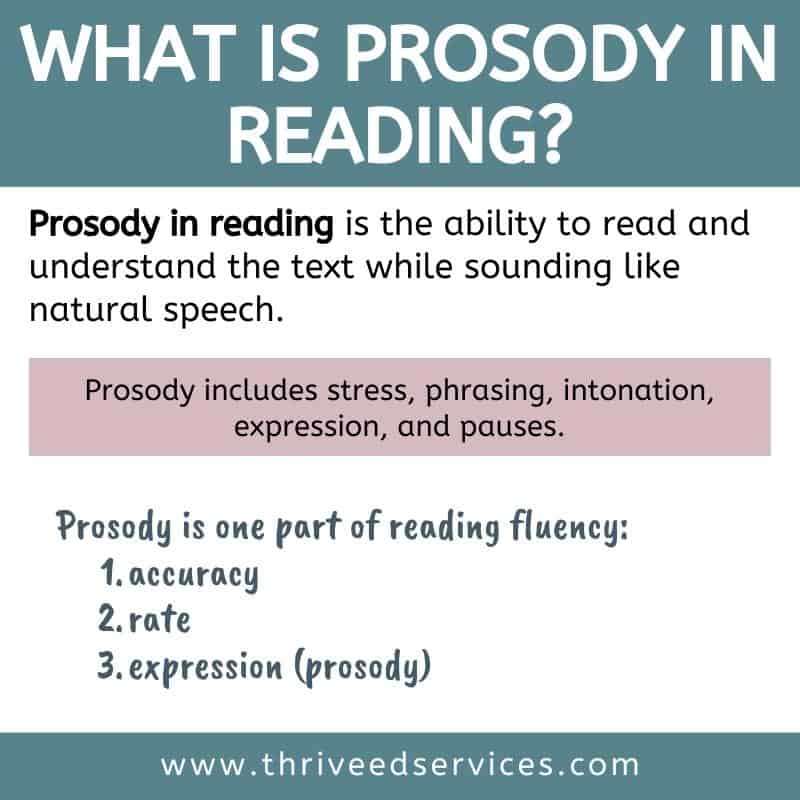Prosody in Reading: Enhancing Fluency and Comprehension
This post may contain affiliate links, and I will earn a commission if you purchase through these links. Please read the disclosure policy for more details.
Prosody plays a vital role in reading and speaking skills. It refers to the rhythm, stress, and intonation of words in a sentence, which helps you convey meaning and emotion when you communicate with others. Developing strong prosodic skills not only enhances speech intelligibility but also improves overall language understanding and reading fluency.
Activities such as reading stories aloud, reader’s theater, or practicing talking punctuation marks will allow students to develop their prosodic skills. Embracing prosody in reading will help students achieve fluency, expressiveness and foster a deeper connection with the material they’re reading.
SCIENCE OF READING QUICK START GUIDE
Grab your FREE guide with the 5 tools you need to get started with SOR!
*Most school spam filters block my emails, so please use a personal email.

Prosody in Reading
Role of Prosody in Comprehension
When you read or speak, it’s essential to pay attention to prosody. Prosody refers to the expressive qualities of your voice, such as rhythm, intonation, and stress patterns. Proper prosody helps convey meaning and emotion in a text or speech, making it easier for the listeners to understand what you’re trying to communicate. For example, when reading aloud, you can use prosody effectively by changing the tone of your voice based on a character’s emotions or the content of the text you’re reading.
One way to improve students’ prosody skills is through practice. Try reading texts aloud that contain various emotions or different types of content, and have students pay close attention to how your voice changes. This can help them better understand how prosody contributes to the overall comprehension of a text.

Importance of Prosody in Fluency
Fluency is an essential aspect of reading, and prosody plays a significant role in developing it. Besides speed and accuracy, prosody is considered an essential factor in reading fluency. When speed and accuracy levels are appropriate, focusing on proper phrasing, expression, and intonation should be the next goal.
As you work on improving your students’ fluency, remember the following points:
- Prosody helps convey meaning, contributing to your overall understanding of a text.
- Practicing reading aloud allows you to receive feedback on your reading prosody, which helps you improve your skills.
- Developing strong prosody skills can lead to better oral reading fluency and, ultimately, a more enriched reading experience.
So, when aiming to enhance reading fluency, don’t forget to work on prosody skills. This will lead to an improved ability to comprehend and enjoy texts as they are read.

Prosodic Elements
Intonation and Stress
When reading aloud, students should pay attention to intonation and stress. Intonation is the variation in pitch or tone of your voice, while stress refers to the emphasis placed on certain syllables or words. Intonation and stress play a vital role in conveying meaning and emotion in spoken language. Practice varying your pitch and applying emphasis on key words so listeners can better understand the message you’re trying to convey.
Rhythm and Pause
Rhythm is the pattern of stressed and unstressed syllables in speech. To improve reading, focus on developing a natural rhythm that mirrors everyday conversation. Think of pauses as the punctuation marks in spoken language. They can help you organize information, provide emphasis, and create a sense of flow in your reading. Becoming aware of rhythm and appropriate pauses can greatly enhance your communication abilities.
Pace or Tempo
The pace or tempo at which you read directly impacts the quality of your delivery. A steady pace allows listeners to easily follow your words, while varying the tempo can add excitement and interest to your reading. Be mindful of your reading speed, adjusting it depending on the content and your audience. Maintaining an engaging pace can greatly improve the effectiveness of your oral communication.
Phrasing
Phrasing refers to the way in which you group words together in a sentence. Effective phrasing can significantly enhance the clarity and expression of your reading. To improve your phrasing, pay attention to the natural divisions within a sentence, such as clauses and punctuation marks. This will help you convey the intended meaning more effectively and make it easier for your listeners to follow and understand your speech.

Developing Prosody
Best Practices for Improving Prosody
To improve your students’ prosody skills, it’s essential to concentrate on the rhythm, stress, and intonation in speech. Here are some practices to aid these skills:
- Listen to good examples: By paying attention to fluent speakers or audio recordings, students can better understand the changes in pitch, intonation, and rhythm.
- Have students record themselves: This allows them to listen back and notice areas where they could improve their prosody.
- Practice reading with expression: Remind students to focus on stress, pausing, and emphasizing while they’re reading.
Oral Reading and Reading Aloud
Oral reading is a powerful way to practice prosody. Here’s how to make the most of it:
- Read alouds: Reading a variety of texts aloud on a regular basis models prosody and other areas of fluency.
- Try repeated readings: Reading a passage multiple times helps reinforce prosody knowledge and improves fluency. Research has shown repeated reading sto be a very effective strategy to improve fluency.
- Partner up: Pair more fluent readers with less fluent readers for short text read alouds.
- Use choral reading: Read a text in unison with a group or use echo reading where one student or a partner reads a line and others repeat it.
- Explore reader’s theater: Students can perform stories by taking on different roles and reading their character’s lines with expression.

Using Literature and Poetry to Practice Prosody
Incorporate literature and poetry into your lessons to enhance prosody:
- Select diverse texts: Choose stories, poems, and plays that exhibit various styles of language, since different texts require different prosodic approaches.
- Focus on dialogue: Dialogues naturally lend themselves to practicing prosody as they often contain intonation and emotional variation.
- Use poetry exercises: Poetry often contains distinct patterns of rhythm and rhyme, which can be invaluable for developing prosody.
Remember to keep students practicing reading in various formats and with different texts, as this will help enhance their prosodic abilities.

Assessing Prosody
It’s important to understand know that “inefficient word reading is the primary barrier to good prosody for most young readers (Schwanenflugel, Hamilton, Wisenbaker, Kuhn, & Stahl, 2004).” For this reason, ensure that students are receiving effective instruction in decoding and that if there is poor prosody, to assess decoding to find if that is the cause.
Tools and Techniques for Evaluation
When assessing prosody in reading, you have various tools and techniques at your disposal. One effective approach is to focus on listening to the oral reading of a passage, which allows you to gauge the reader’s ability to expressively convey meaning.
While listening to oral reading, pay attention to the following:
- Stress: the emphasis placed on certain words or syllables
- Pitch: the variations in voice tone
- Pauses: the breaks taken between phrases or sentences
- Intonation: the rise and fall of the voice
Observe how the reader navigates these factors to convey the overall meaning of the passage.
In addition, consider using some of the tools for assessing prosody, such as:
- Rubrics: Create a scoring guide to evaluate various aspects of prosody, such as appropriate intonation, pacing, phrasing and expression
- Checklists: Develop a list of key components or behaviors to look for during a student’s oral reading performance
- Anecdotal notes: Record your observations of the reader’s performance, including strengths and areas for improvement
Reading Rockets has a great article on assessing fluency with some specific guidelines: Understanding and Assessing Fluency
NAEP and Other Standardized Assessments
When evaluating students’ reading skills on a broader scale, the National Assessment of Education Progress (NAEP) can be a valuable resource. This assessment, administered by the U.S. Department of Education’s Institute of Education Sciences and the National Center for Education Statistics, provides regular snapshots of student achievement in various subject areas, including reading.
While the NAEP may not directly assess prosody, it can still provide valuable insights into students’ overall reading comprehension and fluency. Comparing your students’ prosody assessment results with their NAEP scores can help you identify any discrepancies or patterns between these two measures of reading performance.
Other standardized assessments may also provide useful information on students’ reading abilities, depending on the specific skill focus of those tests. It’s essential to familiarize yourself with the assessment tools used in your educational setting to maximize their usefulness in evaluating prosody and reading fluency.
Keep these tools, techniques, and standardized assessments in mind as you work to evaluate student prosody in reading. These approaches will help you gather valuable data that can inform your instructional decisions and support your students’ reading fluency development.

Prosody and Spoken Language
This section is more of a good-to-know for teachers, especially those working with ELLs or in special education. I found this information extremely helpful as an educator so I hope you do too.
Influence of Dialect and Accent
Prosody can vary depending on dialects and accents. Understanding how dialects and accents influence prosody is essential for effective communication.
Dialects are regional or social variations of a language, and they often have distinct features in terms of vocabulary, grammar, and pronunciation. These differences can affect the prosody of spoken language, which might lead to potential misunderstandings if you’re not familiar with a particular dialect. Similarly, accents refer to the way a group of people pronounce words or the melody in their speech. A unique accent may have specific prosodic patterns that can create challenges for the listener.
To improve your understanding of various dialects and accents, try to expose yourself to a wide range of spoken language forms. Listening to diverse sources will allow you to become familiar with the prosody patterns of different dialects and accents, ultimately enhancing your communication skills.
Aprosodia and its Impact on Communication
Aprosodia is a speech disorder that affects the ability to express or comprehend the melody, rhythm, and intonation patterns characteristic of spoken language. Individuals with aprosodia may have difficulty understanding or conveying emotions, attitudes, or intentions through speech, which can significantly impact communication. For instance, a person with aprosodia may struggle to differentiate between a statement and a question in a conversation.
There are two main types of aprosodia:
- Expressive aprosodia: This type affects your ability to produce the appropriate prosody to convey emotions and intent in your speech.
- Receptive aprosodia: This type affects your ability to comprehend and interpret the prosody of others’ speech.
The appropriate use of prosody is essential for an accurate understanding of a written text and forms a correct internal representation of the words. If you or someone you know is experiencing difficulties with prosody, seeking professional help from a speech-language pathologist can improve communication abilities and overall confidence.
Conclusion
It’s common when working on reading fluency to focus on speed and accuracy, but prosody is equally important for students to sound natural. Prosody involves the use of timing, phrasing, emphasis, and intonation to enhance comprehension and expression during reading aloud (source).
As a reader, developing your prosody skills can greatly improve your overall reading experience. When you are able to read with prosody, you become better at grasping the meaning of the text and expressing that understanding through your voice. This not only benefits you as a reader but also enhances the experience for listeners when you read aloud.
Remember that teaching and learning prosody can greatly enhance the overall reading experience and build reading fluency. By focusing on these aspects, students can foster a deeper connection to the text and improve their overall reading comprehension.
Sources:
- Reading fluency assessment and instruction: What, why, and how?. Roxanne F Hudson; Holly B Lane; Paige C Pullen, The Reading Teacher; May 2005; 58, 8; Research Library Core, pg. 702
- A review of reading prosody acquisition and development. Godde, E., Bosse, ML. & Bailly, G. Read Writ 33, 399–426 (2020). https://doi.org/10.1007/s11145-019-09968-1
- Fourth-Grade Students Reading Aloud: NAEP 2002 Special Study of Oral Reading(NCES 2006–469). Daane, M.C., Campbell, J.R., Grigg, W.S., Goodman, M.J., and Oranje, A. (2005). U.S. Department of Education. Institute of Education Sciences, National Center for Education Statistics. Washington, DC: Government Printing Office.
- The role of prosody in reading comprehension: evidence from poor comprehenders. Groen, M. A., Veenendaal, N. J., and Verhoeven, L. (2019) Journal of Research in Reading, 42: 37– 57.
- A Longitudinal Study of the Development of Reading Prosody as a Dimension of Oral Reading Fluency in Early Elementary School Children. Miller, J. & Schwanenflugel, P. J. (2008). Reading Research Quarterly, 43, 336-354.
- Becoming a fluent reader: Reading skill and prosodic features in the oral reading of young readers. Schwanenflugel, P. J., Hamilton, A. M., Kuhn, M. R., Wisenbaker, J. M., & Stahl, S. A. (2004). Journal of Educational Psychology, 96, 119–129.
Want to remember this? Save Prosody in Reading: Enhancing Fluency & Comprehension to your favorite Pinterest board!



